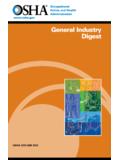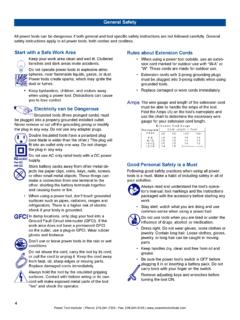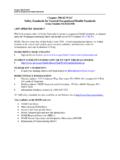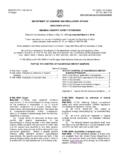Transcription of GENERAL FIRE SAFETY CHECKLIST
1 GENERAL fire SAFETY CHECKLIST Page 1 of 4 Building Exterior Dumpsters more than cubic feet (roll-off) at least 5 from combustible walls, openings, or under eaves and overhangs Outside combustible storage not within 10 of the property line (exception: may be reduced to 3 for piles less than 6 in height or when no hazards to adjacent property exist) Combustible materials not outside of buildings protected by automatic sprinklers stored or displayed under non-sprinklered eaves, canopies or other projections or overhangs fire department apparatus access roads not obstructed Address numbers 4 and/or plainly legible and visible from the street Key box required Key box keys up to date fire hydrants have a 3 clear space in all directions Housekeeping Oily rags and materials subject to spontaneous combustion stored in a list container (sawdust, oily materials (oil based paint & varnish), hay, waste paper, coal and charcoal, pyrophoric metals, incompatible chemicals, oxidizing agents) No fueled vehicles or equipment stored inside (exception.)
2 Fuel tanks have the lesser of a tank or five gallons and batteries disconnected) Storage of combustible material is orderly and separated from heat sources by 3 or shielded (IFC 2003, , referencing NFPA 1, 2006, section ) Storage height is at least 18 below sprinkler deflectors or 2 below a non-sprinklered ceiling Combustibles are not stored in exits or exit enclosures Attics, under floor, concealed spaces used for storage have a 1-hour fire resistance rating on the storage side or are protected by sprinklers. Natural cut trees prohibited (exception: in use groups A, E, M, R-1, and R-2 protected by automatic sprinklers and individual dwelling units in R-2) Assembly Occupancies Open flame devices not allowed in assembly occupancies (Exceptions: approved theatrical performances ( ); where necessary for religious or ceremonial purposes; and candles on tables securely supported on noncombustible bases with flames protected) Flaming food preparation complies with GENERAL fire SAFETY CHECKLIST Page 2 of 4 fire SAFETY and evacuation plan available and quarterly employee drills documented ( ) Combustible curtains, draperies, hangings, and decorative materials suspended from walls or ceilings shall be flame resistant in accordance with NFPA 701.
3 Criteria reports may be required ( ) Class K fire extinguisher within 30 of cooking equipment involving vegetable or animal oils or fats Hoods, grease removal devices, fans, and ducts, are clean and records available Commercial kitchen fire extinguishing system serviced within 6 months Occupant loads posted Building Services Boiler, mechanical, and electrical equipment rooms are not used for storage Rooms containing air-handling or air-conditioning equipment; sprinkler risers and valves or fire alarm panels are marked with a signs MECHANICAL, SPRINKLER CONTROLS or fire PUMP, fire ALARM PANEL or FACP No portable, unvented, fueled-fired heating equipment in use Written documentation available for of the inspection, testing, and maintenance of emergency and standby power systems Working clearance from electrical equipment is width 30, depth 36, and height 78 Electrical room doors are properly marked with a sign Electrical Room Multi-plug adaptors have over-current protection Power taps are polarized grounded and have over-current protection Power taps are directly connected to a permanent receptacle Power taps do not extend through walls, ceilings, floors, under doors or floor coverings nor subject to damage Extension and flexible cords are not affixed to the structure.
4 Extended through walls ceilings or floors Extension cords are plugged directly into an approved receptacle, power tap, or multi-plug adaptor and serve only one portable appliance unless it is an approved multi-plug extension cord The extension cord meets the rated ampacity of the appliance serving the cord Extension cords do not contain splices, deterioration, or damage Extension cords are grounded when serving grounded appliances GENERAL fire SAFETY CHECKLIST Page 3 of 4 All junction boxes, switch and electrical outlet boxes have covers Electrical motors are maintained free of excessive oil, dirt, waste and debris Temporary wiring (construction, remodeling, and holiday lighting) does not exceed 90 days wiring not attached in a manner that damage wiring or create localized resistive heating fire Rated Construction fire rated construction maintained, walls, shafts, fire stops, shaft enclosures, partitions and floors are repaired, restored or replaced when damaged, altered, breached, or penetrated.
5 fire doors and smoke barrier doors not be blocked open or made inoperable (exceptions: magnetic hold open devices ( ) and horizontal and vertical sliding and rolling fire doors tested annually ( )) fire doors close from the full open position and latch automatically fire Protection Systems All fire detection, alarm, and extinguishing systems are maintained in an operating condition ( fire department connection caps in place; valves open; gauges working; spare sprinkler heads and wrench; fire alarm panel has no trouble conditions and power is on; no missing fire alarm devices or appliances) All fire detection, alarm, and extinguishing systems are inspected tested and maintained in accordance with reference standards: 1. Portable fire extinguishers NFPA 10; Carbon dioxide fire -extinguishing system NFPA 12; Halon 1301 fire -extinguishing system NFPA 12A; Dry-chemical extinguishing system NFPA 17; Wet chemical extinguishing system NFPA 17A; Sprinklers NFPA 25; fire alarm NFPA 72; water mist systems NFPA 750; Clean agent extinguishing system NFPA 2001.
6 Records of all inspections, test, and maintenance of fire protection systems available for the past 3 years Valves controlling the water supply for automatic sprinkler systems and water-flow switches on sprinkler systems shall be electrically supervised (Exception: existing installations approved prior to July 31, 2001, may be mechanically supervised with a lock and chain or in a locked room)) (1)(2) A 2A10BC fire extinguisher is within 75 foot travel distance (30 feet of flammable liquids) and there is a least 1 unit of a per 3000 sq. ft. of light hazard and 1 unit of a for 1500 sq. ft. of ordinary hazard. fire extinguishers are in conspicuous locations, readily accessible, and immediately available for use fire extinguishers are not obstructed or obscured from view Handheld fire extinguishers, not housed in cabinets, are installed on hangers and brackets GENERAL fire SAFETY CHECKLIST Page 4 of 4 fire extinguisher cabinets are not locked (exception: in areas where subject to malicious use and damage and provided with a means of ready access) fire extinguisher height does from the top does not exceed 5 above the floor (ADAAG - 3 above the floor if in an accessible area) and no less then 4 from the bottom of the extinguisher to the floor Means of Egress Existing exit signs internally or externally illuminated (exception.
7 Approved self-luminous signs with a minimum luminance foot-lamberts) Existing exit signs equipped with and internal emergency power source shall be visible under emergency power conditions Existing emergency lights operate under emergency power conditions fire escape stairs and balconies shall support a 300 pound dead load plus a live load of not less than 100 pounds per square foot Means of egress are free from obstructions including the accumulation of snow and ice. Furnishing, decorations, other objects do not block exits; hangings, draperies not placed over exit doors or otherwise conceal obstruct an exit; mirrors not placed in a manner to confuse the direction of an exit Required emergency escape openings are maintained and operational inside of the room without the use of keys or tools Hazards Hazardous material is identified with an NFPA 704 placard Rooms or cabinets containing compressed gases labeled COMPRESSED GAS Compressed gas containers, cylinders and tanks secured to prevent falling Compressed gas containers have protective caps in place (Exception: in use) Compressed gas containers, cylinders and tanks not near elevators, unprotected platform ledges, or other areas where falling would result in tanks being allowed to drop distances exceeding one-half the height of the container, cylinder or tank.
8 Compressed gas containers, cylinders and tanks containing non-liquefied gases, shall be stored in an upright position with the valve end up including conditions where the container, cylinder or tank axis is inclined as much as 45 degrees (Exception: those designed for use in a horizontal position) Flammable and combustible liquids in excess of 10 gallons stored in liquid storage cabinets; or if not exceeding 10 gallons, stored in approved containers in private garages or other approved outside location Class I liquids not stored in basement areas. Sprinkler protection required for class II and IIIA liquids stored in basements







